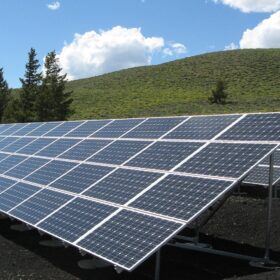- Twenty countries will surpass 500 megawatts in annual solar installations — The number of significant solar photovoltaic markets has been growing steadily over the past 10 years, alongside an increasing volume of installations in new markets. Ultimately, how solar demand in 2018 unfolds will hinge on global module prices, steered by events in the top three markets, as well as by local policies and developer activity.
- Floating solar moves beyond niche applications — Floating solar photovoltaic systems are increasingly deployed on dams, reservoirs, lakes and other water bodies across the world. In 2018, the technology for these systems will move from niche applications to steady market uptake.
- Bifacial and half-cell technologies are the new rising module stars —Because bifacial technology enables power to be generated from both the front side and rear side of the panel, it can potentially generate 10 to 15 percent more electricity than standard modules, accompanied by only a limited increase in costs; while half-cell technology allows more cells to be placed into a module of a given size, increasing power output by 5 to 10 watts. For both technologies, the increased output from a single module will also contribute to system cost reductions on a per-watt basis.
- Diamond wire implemented for multicrystalline wafer cutting — The main cause of the resurgence of multicrystalline wafer cutting is the massive implementation of diamond wire sawing. The use of diamond wire saws for cutting multicrystalline wafers will reach significant penetration rates, with major manufacturers entering mass production in 2018.
- US and India trade policies impact module prices and procurement trends — Recent trade developments in the United States and India, the second- and third-largest solar markets, are expected to have broad implications on manufacturing investment and expansion over the next few years in both local and international markets.
- PV inverter suppliers race to build new digital business models — Many suppliers are looking to create new business models, including the creation of a digital services platform that combines the core strength of suppliers in providing PV inverter hardware, with the addition of a software and cloud platform. This way, suppliers can work seamlessly with new partners in parallel industries, such as e-mobility, energy storage, lighting, heating and cooling.
- Utility-scale solar plus storage takes center stage — Intermittency is the inherent challenge with solar technology as a large-scale energy generator. The combination of solar and batteries has long been recognized as a solution to this problem, smoothing the variations in a plant’s output and storing electricity during the day, which enables the system to provide power into the evening.
- Electric vehicles pave the way for new synergies with stationary energy storage — The growth and future promise of electric vehicles has been a major factor in driving down the cost of batteries for energy storage, thanks to huge investments in battery technology and scale. EV growth will continue, but the various synergies between stationary energy storage and the reuse of “second-life” batteries from electric vehicles will also be increasingly explored.
This content is protected by copyright and may not be reused. If you want to cooperate with us and would like to reuse some of our content, please contact: editors@pv-magazine.com.








By submitting this form you agree to pv magazine using your data for the purposes of publishing your comment.
Your personal data will only be disclosed or otherwise transmitted to third parties for the purposes of spam filtering or if this is necessary for technical maintenance of the website. Any other transfer to third parties will not take place unless this is justified on the basis of applicable data protection regulations or if pv magazine is legally obliged to do so.
You may revoke this consent at any time with effect for the future, in which case your personal data will be deleted immediately. Otherwise, your data will be deleted if pv magazine has processed your request or the purpose of data storage is fulfilled.
Further information on data privacy can be found in our Data Protection Policy.